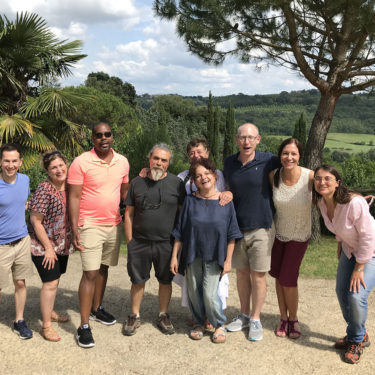The National Gallery of Umbria is one of Perugia’s most important museums. It’s also the only major art collection in Italy to be housed in the same building as the municipal government—Palazzo dei Priori. If you’re a lover of art history and ancient architecture, GNU (short for the gallery’s Italian name—Galleria Nazionale dell’Umbria) is a must-see stop on your next visit to Perugia.
In the gallery’s rooms, visitors can view masterpieces by Arnolfo di Cambio, Nicola and Giovanni Pisano, Duccio di Buoninsegna, Gentile da Fabriano, Beato Angelico, Benozzo Gozzoli, Pietro Vannucci (a.k.a. Il Perugino), Piero della Francesca and other artists you may or may not know whose work spans the thirteenth to the nineteenth centuries.
But the museum is not just a succession of gold-leafed altarpieces depicting the virgin mother, countless saints and divine interventions. A recent renovation in 2022 has breathed new life into the palazzo and the gallery. Among the upgrades are digital displays and video presentations, plus new signage with detailed explanations in Italian and English. The inclusion of several of Umbria’s more contemporary artists and a new mural by Roberto Paci Dalò brings the National Gallery of Umbria’s impressive collection into the current century.
Here are eight reasons why the National Gallery of Umbria is worth visiting.
1. The beauty of the architecture
The museum is located on the upper floors of The Palazzo dei Priori, Perugia’s municipal building. This architectural masterpiece holds within its walls the ghosts of centuries-long power struggles and countless civic disputes. It captivates you with an incomparable air of majesty. Imagine yourself as you enter through a magnificent Romanesque portal and meander across a medieval stone atrium to reach the museum’s book shop. Here you purchase tickets. Then you can take the elevator—or ascend the age-worn, sandstone staircase where many a pauper and potentate have walked before. Once inside the museum’s gallery rooms, you will stroll through a maze of varied rooms, some with high arches, frescoed ceilings and secret little corners. Many of these windows provide birds-eye views of the rooftops and streets below.
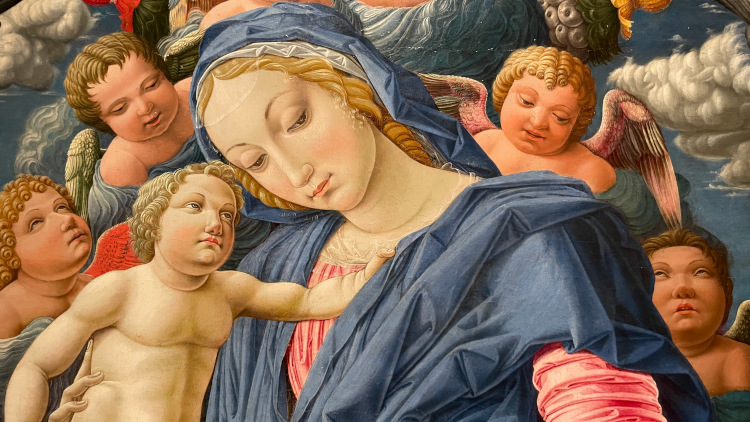
“Madonna col Bambino e Angeli” by Bartolomeo Caporali
2. Paintings, sculptures, metalwork, pottery
The works are not only religious in nature. On display in the galleries and arranged in chronological order are paintings and sculptures, gold and metalwork, Umbrian fabrics and pottery, intricately carved wedding chests, ivory boxes, jewelry and other decorative arts. Gallery 21 displays objects used in everyday life. Some of these were related to the functions of Perugia’s earliest government. Two elaborately carved and painted ballot boxes are on display here. One of these was used for the election of the Decemvirs. These ten officials were the priors (the city government at the time) made up of representatives from Perugia’s medieval trade guilds. Proving that election fraud was a worrying topic even back then, the boxes were kept hidden in the municipal archives. To protect the integrity of their contents, they could only be opened using four keys held by four different people.
3. Recent restoration and upgrades
New upgrades to the museum galleries include detailed Italian and English language explanations—not only of individual artworks but also about the artists and the progression of styles from primitive to realism. Many rooms now have digital screens that take a deep dive into how some of the works were restored. Other screens detail artistic techniques by zooming in on the brushwork and precious metals used by the artists. One example is Gallery 3, the former Chapel of the Priors. The digital presentation explains the 15th-century frescoes on the wall and shows where some of the scenes depicted are located throughout present-day Perugia. A soundtrack of evocative chanting adds ambiance to this room. On the modern end of the spectrum, Gallery 39 is dedicated to twentieth-century artists. Works by Gerardo Dottori and Alberto Burri will be part of the National Gallery of Umbria’s permanent collection. The room will also use this space to rotate works by a range of artists who have chosen to live and to work in Umbria.
4. Perugia’s patron saints
Cities in Italy usually have a patron saint. Perugia has three—San Lorenzo (St. Lawrence) Sant’Ercolano (St. Herculanus) and San Costanzo (St. Constantius). When entering Palazzo dei Priori, you will see statues of this trio just above the door. The original marble statues carved in the 1300s by Maestro della Madonna di Sant’Agostino (a fitting name for sculpting saints) are on display in Gallery 5. The intricacy of carved details on these statues, with their flowing, brocaded robes is impressive. Signage explains the influence of Florentine and Sienese painters, sculptors and goldsmiths of the time who were practicing a completely new form of realism. This influence reached Umbria early due to the construction of the Basilica in Assisi, with its Giotto frescoes and the Cathedral in Orvieto.
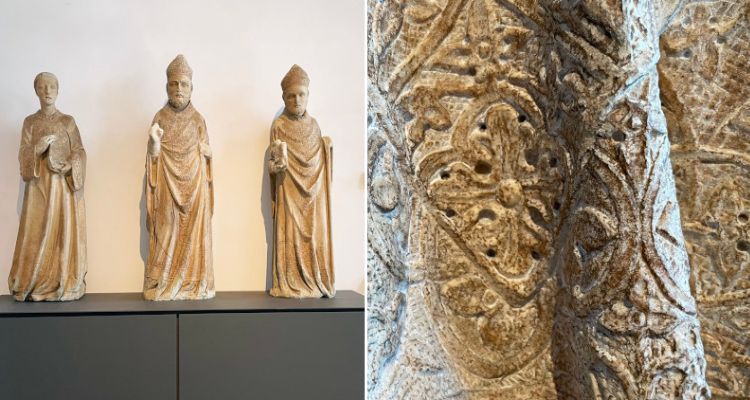
The three patron saints of Perugia and a detail of the intricate carvings
5. The Farnese Room Gallery 19
This gallery had been the Summer Hall of the Government Congregation, built after the Salt War in 1540. The project was undertaken to adapt the apartments of the Priors to their new function of housing the papal governor. The room features a coffered wooden ceiling with an elaborately painted frieze. New signage also corrects the record about what is depicted in the frieze. Previously the subjects of the paintings were mistakenly interpreted as stories about the life of Braccio Fortebraccio—a ruthless mercenary of the epoch. Instead, the illustrations sing the praises of the Farnese family, as in Pope Paul III, who famously repressed the Perugians, then mercilessly crushed them during the Salt War. The woodwork by Annibale Angelini and paintings by Lattanzio Pagani and Tommaso di Arcangelo di Bernabeo are masterfully done. Though it is further explained that the most accomplished Perugian artists of the time were excluded from these commissions—a reflection of the political climate of the times.
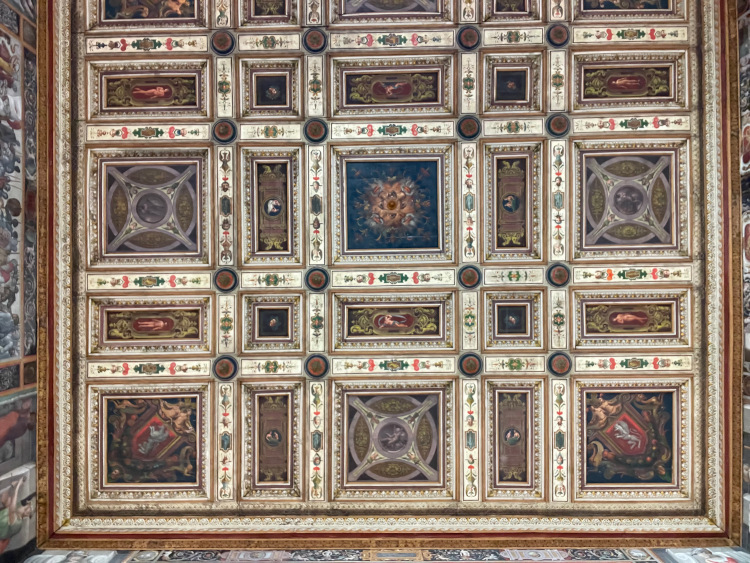
The coffered wooden ceiling
6. Ductus, a mural and defacto museum guide
Gallery 20 now features a new mural painted by Roberto Paci Dalò, a visual artist, composer, musician and author who was commissioned by the National Gallery of Umbria to create a book celebrating the museum’s hundred-year anniversary. This is no rigidly indexed coffee table book. Ombre (Shadows) is like an artist’s sketchbook containing pages of pencil, watercolor and ink drawings with words, thoughts, inspirations. It reinterprets the collections housed in the gallery including masterpieces by Duccio, Piero della Francesca, Perugino and Pinturicchio. The mural inside the gallery could be considered a defacto guide to the museum collections. The images and words create a whimsical timeline that captures the political and artistic history of Perugia. One fact stood out. The famous and celebrated Perugino died of the plague in 1523. I later read that he was unceremoniously buried in an unmarked grave—its precise location remains unknown.
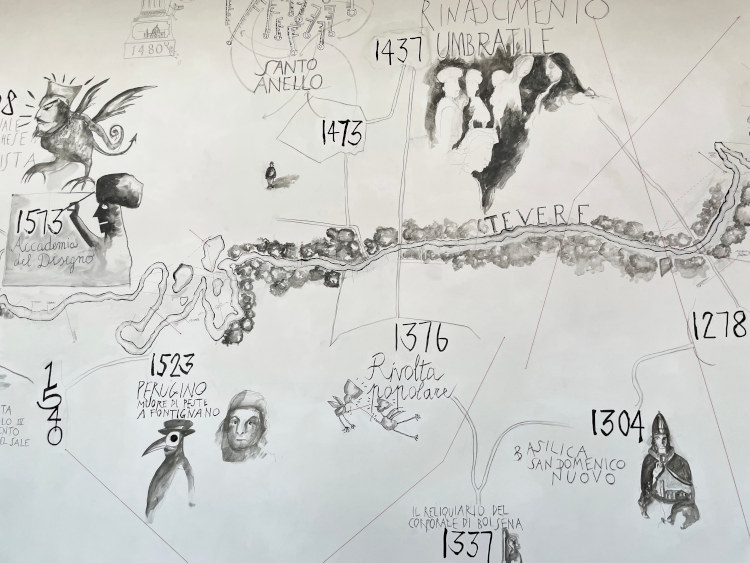
A detail of Ductus
7. Perugia’s clock tower and the giant antique clock
One beautiful and quiet room is located inside Perugia’s clock tower. It was used in the 1500s as the headquarters of the “spenditori,” i.e., the people who purchased the priors’ food and other provisions. The giant antique clock is like a window looking down at Corso Vannucci. The room still retains fragments of the coats of arms of some of the priors. It now contains two new elements. One is a 3D multimedia presentation that shows the construction of Palazzo dei Priori over several building phases from the 1300s to the 1800s. Another screen shows a mini documentary about Aldo Capitini, a philosopher, anti-fascist and pacifist, born and raised in Perugia. Capitini’s father had been a municipal employee, the keeper of the belltower. Aldo lived in this very same room as a boy. A video about his life playing on a continual loop in this peaceful setting was an obvious choice. On the day of my visit, two young parents were sitting on the comfortable chairs while their daughters sat quietly in the light of the clock face drawing in their coloring books.
8. A dazzling array of wonderfully vibrant works
As I mentioned before, the National Gallery of Umbria is not just a bunch of religious works. But I’m not going to lie. There are plenty of angels and rosy-cheeked cherubs. These are interspersed with solemn worshippers and suffering martyrs. There’s a dazzling array of Annunciations, Flagellations, Adorations and Coronations. Sprinkled in are a few crucifixions along with countless versions of the Madonna and Child. But many of these works are wonderfully vibrant and well preserved. They bring to life in rich jewel tones and with intricate details, the incredible talents of the artists and artisans whose calling was to document the trials and tribulations, the divine and the ordinary, the glory and sometimes the shame of these many centuries of Umbrian history and culture.
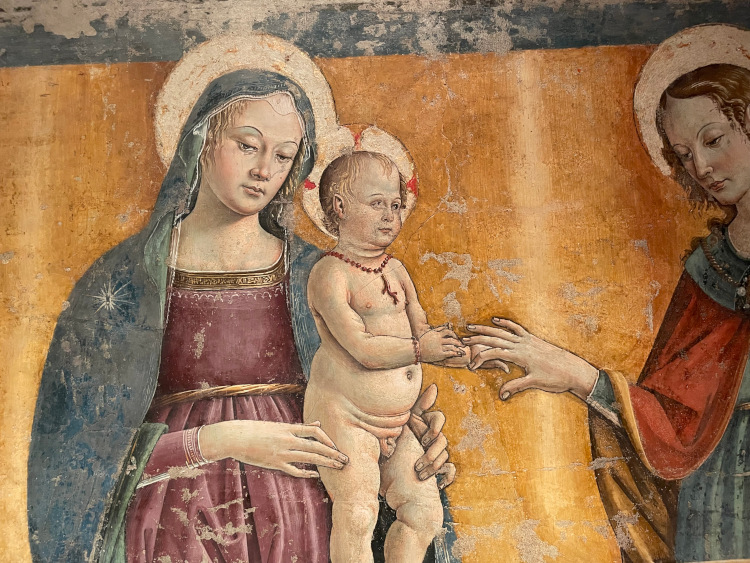
Painting by Fiorenzo di Lorenzo
Would you like to discover more of Perugia’s museums?
Sign up for our newsletter to receive our insider tips in your inbox or book an authentic tour with Via Del Vino!
If you would like to check the opening times, ticket prices and other information about the National Gallery of Umbria, please visit the website of Galleria Nazionale dell’Umbria.
NOTE:
This article was first published in 2017 and last updated in 2022.
corso vannucci , fontana , museum , palazzo , perugino













